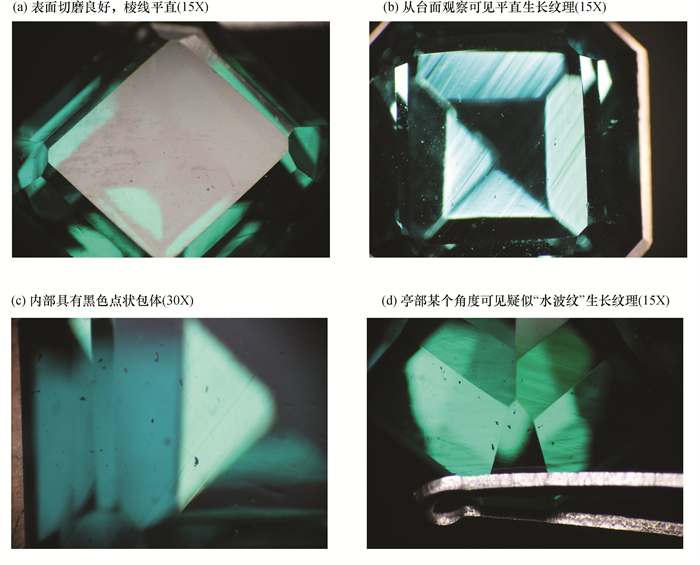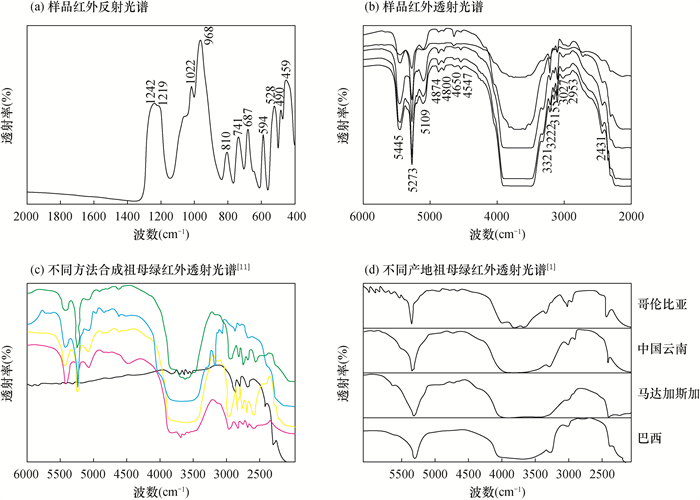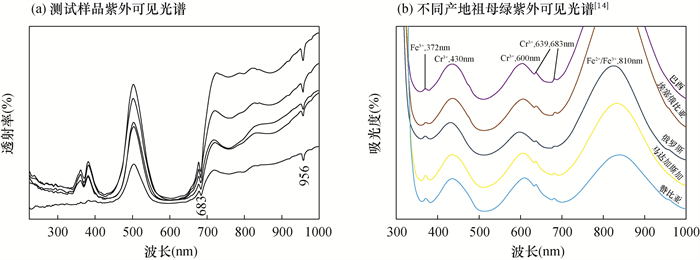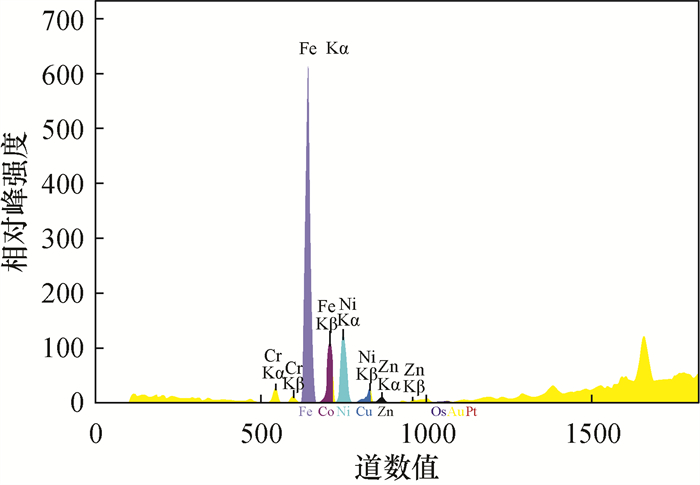Gemological and Spectral Characteristics of a New Type of Emerald Synthesized by the Hydrothermal Method
-
摘要:
水热法是合成祖母绿的常用方法之一,使用该方法合成的祖母绿具有典型“水波纹”状纹理,呈现锯齿状平行排列,且其红外透射吸收光谱在2300~3100cm-1的特征峰是主要鉴定特征。但目前市场上新出现的水热法合成的一种祖母绿不具有上述典型特征。为探究这种水热法合成的祖母绿的宝石学和光谱学特征,本文采用常规宝石学仪器宝石显微镜、折射仪等及红外吸收光谱仪、紫外可见光谱仪、能量色散X射线荧光光谱仪(EDXRF)对其鉴定特征进行研究分析。结果表明:测试样品的折射率为1.571~1.588,双折射率为0.007~0.009,相对密度为2.56~2.78,多色性明显,这些特征与天然祖母绿相似,红外吸收光谱特征与天然祖母绿基本一致。在宝石显微镜下,从特定角度观察可见疑似水热法合成祖母绿的“水波纹”状纹理,呈平行状,但不是典型的锯齿状平行排列,属于疑惑样品。红外透射吸收光谱具有Ⅰ型水和Ⅱ型水的尖锐吸收峰,在2300~3100cm-1范围内的吸收相对较弱,不具有诊断意义;紫外可见光谱分析表明Fe2+离子引起的810~850nm吸收宽带不明显,但810~850nm范围内的特征吸收带是天然祖母绿的重要鉴定特征。能量色散X射线荧光光谱仪(EDXRF)分析显示样品含有异常高的Ni元素,其Ni元素的Κα峰强度远大于Cr元素的Κα峰强度(2倍以上),但研究表明世界各地的天然祖母绿中几乎不含Ni元素,或Ni元素含量低于Cr元素含量的2‰。经综合分析这种水热法合成的新型祖母绿的关键鉴定特征是,在结合紫外可见吸收光谱特征即Fe2+离子引起的810~850nm吸收宽带不明显的同时,重点关注EDXRF测试结果,其Ni元素的Κα峰强度显著大于Cr元素的Κα峰强度。
Abstract:BACKGROUND The emerald is loved by people because of its gorgeous color and is respected as one of the world's four major gems. Due to the high value of emeralds, a variety of synthesis and optimization methods have emerged. The hydrothermal method is one of the common methods to produce synthetic emeralds. The emeralds synthesized by this method have typical water ripple texture, showing a serrated parallel arrangement, and the characteristic peaks of the infrared absorption spectrum in the range of 2300-3100cm-1 are the main identification feature. However, some emeralds synthesized by this method do not have the above typical characteristics. This has brought a great challenge to the quality inspection agencies, and brought many doubts to the majority of consumers, and affected the stability of the gem market.
OBJECTIVES It is essential to study the new emerald synthesized by this new hydrothermal method. The refractive index, density, polychromatism, and infrared absorption spectrum characteristics of the tested samples are very similar to those of natural emeralds, so infrared absorption spectrum analysis cannot obtain the supporting evidence of its cause. Based on this, the gemological and spectral characteristics of the test samples were studied by ultraviolet visible spectrum, energy dispersive X-ray fluorescence spectrometry (EDXRF) and other spectroscopic means. Finally, the test samples were determined to be a new kind of emerald synthesized by the hydrothermal method.
METHODS The refractive index, birefringence, relative density, polychromaticity and weight of the samples were tested by refractometer, electronic balance, and dichroic mirror. The internal and external characteristics of the test samples, the cutting and polishing quality of the samples, and the characteristics of internal inclusions were observed by gem microscope. The infrared reflection spectrum and infrared transmission spectrum characteristics of the samples were analyzed by Fourier transform infrared spectrometer and compared with the infrared spectrum characteristics of emeralds from different origins. The absorption spectrum characteristics of the samples were analyzed by ultraviolet-visible spectrometer, focusing on the absorption peak characteristics near 830nm. The element characteristics of the samples were tested by EDXRF, because the content characteristics of Cr and Ni in emerald are the key to identify whether it is natural or not.
RESULTS The mass of the tested samples was 0.17-0.56g, the refractive index was 1.571-1.588, the birefringence was 0.007-0.009, the relative density was 2.56-2.78, and the polychromaticity was obviously blue-green/green. These conventional gemological characteristics were consistent with natural emeralds. The samples were observed under a gemstone microscope, and the samples had a parallel texture of suspected water ripple, but not typical. The water ripple texture of the typical hydrothermal synthetic emeralds was serrated parallel arrangement. However, the characteristics under the gem microscope should arouse the suspicion of jewelry inspectors.
The infrared reflectance spectra of the samples had characteristic peaks of 1242, 1219, 1022, 968, 810, 741, 687, 594, 528, 490, and 459cm-1. The characteristic peaks of 1242, 1219, 1022, 968, 810, 741, and 687cm-1 were caused by the stretching vibration of Si—O—Si and O—Si—O, and the characteristic peaks of 594, 528, 490, and 459cm-1 were caused by the bending vibration of Si—O and the vibration of M—O. The infrared reflection spectrum characteristics of the samples were consistent with the infrared spectrum characteristics of beryl, but the infrared spectrum characteristics of the fingerprint area could not indicate whether the samples were natural or synthetic.
The infrared transmission spectra of the samples had 5445, 5273, 5109, 4874, 4800, 4650, 4547, 3321, 3222, 3027, 2953, 2928, and 2431cm-1 characteristic peaks. 5273cm-1 was caused by typeⅡ water absorption, 5445cm-1 and 5109cm-1 were caused by typeⅠ water absorption. The typeⅡ water absorption peak of the test samples was relatively sharp at 5273cm-1, and the typeⅠ water absorption peaks at 5445cm-1 and 5109cm-1 were relatively strong. Compared with previous studies, the shape and intensity of water absorption peaks of natural emerald and hydrothermally synthesized emerald were different. The infrared absorption spectrum characteristics of the water of the test sample were different from those of natural emerald, but the diagnostic direct evidence could not be obtained from the infrared absorption spectrum. The infrared peak in the range of 2300-3100cm-1 is caused by Cl- ion absorption. According to the results of previous studies, the absorption intensity of hydrothermal synthetic emeralds in this wavenumber range was significantly stronger than that of natural emeralds. The infrared absorption spectra of the test samples were relatively weak in the range of 2300-3100cm-1, which was more similar to the infrared absorption spectrum characteristics of natural emeralds in Colombia, Yunnan, Madagascar and Brazil, and was obviously different from the infrared absorption spectrum results of emeralds synthesized by the hydrothermal method. There were obvious differences between the infrared transmission absorption spectra of the traditional hydrothermal synthetic emeralds and natural emeralds. The characteristics of infrared absorption spectra are important evidence for identifying the genesis of emeralds. However, it is difficult to obtain the final accurate conclusion from the infrared absorption spectrum analysis of the test samples described in this paper, so they have been named 'new' type.
The UV-Visible spectrum characteristics of the test samples showed that the absorption peak below 350nm was caused by the Fe2+-O2- charge transfer band in emerald, the absorption peak at 429nm was caused by Cr3+ ions, the broad absorption band at 550-650nm was mainly caused by Cr3+ ions, the absorption peak at 683nm was caused by Cr3+ ions, the sharp absorption peak at 956nm was caused by water absorption, and the broad absorption peak near 850nm should be caused by Fe2+ absorption, which was rarely seen in the previous hydrothermal synthesis of emerald. The combination of Cr3+ and Fe3+ replacing Al3+ makes emerald, green. The absorption peak of UV-Visible spectrum caused by Fe2+ in natural emerald was in the range of 810-850nm, and only a few of the absorption bands caused by Fe2+ in natural emeralds are not obvious. The absorption band of the UV-Visible spectra of the test samples was not obvious or weak in the range of 810-850nm, and the 850nm absorption peak of individual samples was obvious. Therefore, the emeralds examined by ultraviolet-visible spectroscopy may be synthetic, but this could not be conclusively confirmed.
The EDXRF results showed that the samples had Fe, Ni and Cr elements, which was different from previous studies of natural emeralds. Yang Zhuo(2010) studies showed that the main trace elements in natural emeralds, from different origins such as Brazil, Colombia, Egypt, India, South Africa, Zimbabwe and Canada by LA-ICP-MS, were Fe, V, Cr, Mg, Na and Cs, but the content of Ni was very low, far lower than that of Cr. The content of Cr in Yunnan emeralds was 58-177μg/g, and Ni was not detected (Bai et al., 2019). The chemical element characteristics of gem-grade emeralds in Afghanistan, Brazil, Colombia, Ethiopia, Madagascar, Russia, Zambia and Zimbabwe showed that Ni element was not detected (Karampelas et al., 2019). The elemental composition of emeralds from South Africa, Afghanistan, Australia, Colombia, Egypt, Madagascar, Zambia, Zimbabwe, Tanzania and China was analyzed by electron probe microanalysis, and Ni was not detected (Lum et al., 2016). It could be seen that Cr and Fe elements coexisted in natural emeralds, but Ni was almost non-existent. EDXRF was used in this study without quantitative analysis but calibrated by the gold standard sample, and the relative peak intensity of the element was of great significance. The peak intensity of the Ni element in the test sample was much higher than that of the Cr element, which did not conform to the element content characteristics of the natural emerald, and was consistent with the high content of Ni in the hydrothermal synthesis of emerald reported by Lu and Shen (2021) and Yang et al.(2022). The comprehensive analysis showed that the test sample was a synthetic emerald.
CONCLUSIONS The infrared absorption spectrum characteristics of the test samples are similar to those of natural emeralds, and the infrared absorption spectrum could not be used as a basis for identifying the genesis of emeralds. Previous studies show that a set of absorption peaks in the range of 2300-3100cm-1 in the infrared absorption spectrum is an important identification feature of the hydrothermal synthesis of emeralds, but this feature is not obvious in the tested samples. The UV-Visible spectrum of the sample shows that the absorption band near 810-850nm related to Fe2+ is not obvious. The X-ray fluorescence spectra of the samples show that the Kα peak intensity of Ni is much higher than that Kα of Cr, which is the main feature of the new emerald synthesized by the hydrothermal method. It could be seen from the experimental results that the identification of jewelry and jade is a systematic work. It is necessary to learn from the previous results and combine the comprehensive analysis of various detection methods to obtain the correct result.
-

-
表 1 样品的规格、折射率、相对密度、多色性特征
Table 1. Size, refractive index, relative density, and polychromatic characteristics of the samples
样品编号 质量(g) 尺寸(mm) 折射率 双折射率 相对密度 多色性特征 1 0.5583 8.47×8.02×5.83 1.573~1.580 0.007 2.56 明显:蓝绿色/绿色 2 0.1748 7.01×4.98×3.53 1.572~1.581 0.009 2.72 明显:蓝绿色/绿色 3 0.1803 6.99×4.98×3.50 1.578~1.585 0.007 2.69 明显:蓝绿色/绿色 4 0.2067 7.95×5.94×3.71 1.579~1.588 0.009 2.75 明显:蓝绿色/绿色 5 0.2015 7.98×5.98×3.66 1.571~1.579 0.008 2.78 明显:蓝绿色/绿色 -
[1] 石国华. 桂林水热法合成祖母绿红外光谱特性及其意义[J]. 宝石和宝石学杂志, 1999, 1(1): 40-44. https://www.cnki.com.cn/Article/CJFDTOTAL-BSHB199901009.htm
Shi G H. FTIR features of Guilin hydrothermally-grown synthetic emerald and its significance[J]. Journal of Gems and Gemmology, 1999, 1(1): 40-44. https://www.cnki.com.cn/Article/CJFDTOTAL-BSHB199901009.htm
[2] 杨卓. 云南和其他地区祖母绿产地特征的对比研究[D]. 北京: 中国地质大学(北京), 2010.
Yang Z. Comparative study on locality features of emerald in Yunnan and which in other areas of the world[D]. Beijing: China University of Geosciences (Beijing), 2010.
[3] 孙主, 李娅丽. 俄罗斯水热法合成祖母绿的宝石学特征研究[J]. 宝石和宝石学杂志, 2010, 12(1): 12-15. doi: 10.3969/j.issn.1008-214X.2010.01.003
Sun Z, Li Y L. Study on gemological characteristics of Russian hydrothermal synthetic emerald[J]. Journal of Gems and Gemology, 2010, 12(1): 12-15. doi: 10.3969/j.issn.1008-214X.2010.01.003
[4] 申柯娅. 天然祖母绿与合成祖母绿的成分及红外吸收光谱研究[J]. 岩矿测试, 2011, 30(2): 233-237. doi: 10.3969/j.issn.0254-5357.2011.02.024 http://www.ykcs.ac.cn/cn/article/id/ce380698-cdb7-491c-8284-258a85a55ac4
Shen K Y. Study on chemical compositions and infrared absorption spectra of natural and synthetic emeralds[J]. Rock and Mineral Analysis, 2011, 30(2): 233-237. doi: 10.3969/j.issn.0254-5357.2011.02.024 http://www.ykcs.ac.cn/cn/article/id/ce380698-cdb7-491c-8284-258a85a55ac4
[5] 邵慧娟, 亓利剑, 钟倩, 等. 俄罗斯富铁型水热法合成祖母绿特征研究[J]. 宝石和宝石学杂志, 2014, 16(1): 26-34. doi: 10.3969/j.issn.1008-214X.2014.01.004
Shao H J, Qi L J, Zhong Q, et al. Study on characteristics of iron-rich hydrothermal synthetic emerald from Russia[J]. Journal of Gems and Gemology, 2014, 16(1): 26-34. doi: 10.3969/j.issn.1008-214X.2014.01.004
[6] Karampelas S, Al-Shaybani B, Mohamed F, et al. Emer-alds from the most important occurrences: Chemical and spectroscopic data[J]. Minerals, 2019, 9: 561-590.
[7] Huong L T, Hofmeister W, Häger T, et al. A preliminary study on the separation of natural and synthetic emeralds using vibrational spectroscopy[J]. Gems & Gemology, 2014, 50(4): 287-292.
[8] 吴瑾光. 近代傅里叶变换红外光谱技术及应用[M]. 北京: 科学技术文献出版社, 1994.
Wu J G. Modern Fourier transform infrared spectroscopy and its application[M]. Beijing: Science and Technology Literature Press, 1994.
[9] 彭文世, 刘高魁. 矿物红外光谱图集[M]. 北京: 科学出版社, 1982.
Peng W S, Liu G K. Atlas of mineral infrared spectro-scopy[M]. Beijing: Science Press, 1982.
[10] 张嘉麟, 张倩, 裴景成, 等. 水热法合成蓝绿色绿柱石的宝石学及光谱学特征[J]. 光谱学与光谱分析, 2021, 41(7): 2258-2262. https://www.cnki.com.cn/Article/CJFDTOTAL-GUAN202107050.htm
Zhang J L, Zhang Q, Pei J C, et al. Gemological and spectroscopy characteristics of synthetic blue-green beryl by hydrothermal method[J]. Spectroscopy and Spectral Analysis, 2021, 41(7): 2258-2262. https://www.cnki.com.cn/Article/CJFDTOTAL-GUAN202107050.htm
[11] 张蓓莉. 系统宝石学[M]. 北京: 地质出版社, 2006.
Zhang B L. Systematic gemology[M]. Beijing: Geology Press, 2006.
[12] Wood D L, Nassau K. The characterization of beryl and emerald by visible and infrared absorption spectroscopy[J]. American Mineralogist, 1968, 53(5-6): 777-800.
[13] Qin L J, Yu X Y, Guo H S. Fluid inclusion and chemical composition characteristics of emeralds from Rajasthan area, India[J]. Minerals, 2022, 12: 1-20.
[14] Saeseaw S, Nathan D R, Aaron C P, et al. Geographic origin determination of emerald[J]. Gems & Gemology, 2019, 55(4): 614-646.
[15] Guo H S, Yu X Y, Zheng Y Y, et al. Inclusion and trace element characteristics of emeralds from Swat Valley, Pakistan[J]. Gems & Gemology, 2020, 56(3): 336-355.
[16] Krzemnicki M S, Wang H A O, Büche S. A new type of emerald from Afghanistans Panjshir Valley[J]. The Journal of Gemology, 2021, 37(5): 474-495. doi: 10.15506/JoG.2021.37.5.474
[17] Bai F, Pan H H, Li X M. Replacement degree of Al3+ and Cr/V ratio in high-V emeralds from Malipo, Yunnan, China[J]. Arabian Journal of Geosciences, 2019, 12: 376-385. doi: 10.1007/s12517-019-4534-6
[18] 乔鑫, 周征宇, 农佩臻, 等. 贫碱结构水类型祖母绿红外光谱特征及其控制因素探究[J]. 岩矿测试, 2019, 38(2): 169-178. http://www.ykcs.ac.cn/cn/article/doi/10.15898/j.cnki.11-2131/td.201804070039
Qiao X, Zhou Z Y, Nong P Z, et al. Study on the infrared spectral characteristics of H2O Ⅰ-type emerald and the controlling factors[J]. Rock and Mineral Analysis, 2019, 38(2): 169-178. http://www.ykcs.ac.cn/cn/article/doi/10.15898/j.cnki.11-2131/td.201804070039
[19] Pignatelli I, Giuliani G, Ohnenstetter D. Colombian trapi-che emeralds: Recent advances in understanding their formation[J]. Gems & Gemology, 2015, 51(3): 222-259.
[20] Lum J E, Viljoen K S, Cairncross B. Mineralogical and geochemical characteristics of emeralds from the Leydsdorp area, South African[J]. South African Journal of Geology, 2016, 119(2): 359-378.
[21] 任伟, 汪立今, 李甲平. 电子探针和X射线衍射仪测定新疆祖母绿宝石[J]. 岩矿测试, 2010, 29(2): 179-181. http://www.ykcs.ac.cn/cn/article/id/5a9e1771-8bd3-42f9-b2fc-d5fe67a5c11f
Ren W, Wang L J, Li J P. Detection of emerald from Xinjiang by electron probe microanalyzer and X-ray diffractometer[J]. Rock and Mineral Analysis, 2010, 29(2): 179-181. http://www.ykcs.ac.cn/cn/article/id/5a9e1771-8bd3-42f9-b2fc-d5fe67a5c11f
[22] 代鸿章, 王登红, 刘丽君, 等. 电子探针和微区X射线衍射研究陕西镇安钨-铍多金属矿床中祖母绿级绿柱石[J]. 岩矿测试, 2018, 37(3): 336-345. http://www.ykcs.ac.cn/cn/article/doi/10.15898/j.cnki.11-2131/td.201712140193
Dai H Z, Wang D H, Liu L J, et al. Study on emerald-level beryl from the Zhen'an W-Be polymetallic deposit in Shaanxi Province by electron probe microanalyzer and micro X-ray diffractometer[J]. Rock and Mineral Analysis, 2018, 37(3): 336-345. http://www.ykcs.ac.cn/cn/article/doi/10.15898/j.cnki.11-2131/td.201712140193
[23] 卢磊, 沈锡田. 市场上"重结晶祖母绿"的鉴定特征[J]. 宝石和宝石学杂志, 2021, 3(5): 51-59. https://www.cnki.com.cn/Article/CJFDTOTAL-BSHB202105006.htm
Lu L, Shen X T. Identification characteristics of "recrystallized synthetic emerald"[J]. Journal of Gems and Gemology, 2021, 3(5): 51-59. https://www.cnki.com.cn/Article/CJFDTOTAL-BSHB202105006.htm
[24] 杨燕菱, 沈锡田, 范玉蓉, 等. 俄罗斯富钒型水热法合成祖母绿的紫外-可见-近红外光谱表征[J]. 光谱学与光谱分析, 2022, 42(4): 1199-1203. https://www.cnki.com.cn/Article/CJFDTOTAL-GUAN202204034.htm
Yang Y L, Shen X T, Fan Y R, et al. UV-Vis-NIR spectroscopic characteristics of vanadium-rich hydrothermal synthetic emeralds from Russia[J]. Spectroscopy and Spectral Analysis, 2022, 42(4): 1199-1203. https://www.cnki.com.cn/Article/CJFDTOTAL-GUAN202204034.htm
-




 下载:
下载:


